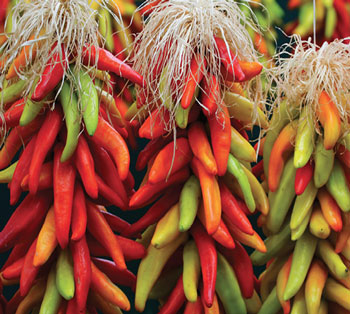Guide H-149
Revised by David G. Kraenzel
College of Agricultural, Consumer and Environmental Sciences, New Mexico State University
Author: Research Associate Professor, Department of Agricultural Economics and Agricultural Business, New Mexico State University. (Print friendly PDF)
Marketing is very important for small-scale agricultural producers, and interest among producers in marketing their own products continues to increase. With this interest comes the need for information about marketing choices. The following is a list of crop and livestock marketing choices and issues the individual producer should consider.
- Commission Agents (Brokers): A broker or aggregator negotiates a contract between the seller (producer) and the buyer. The broker is paid a percentage commission based on the sales price (i.e., auction sale price) or weight (i.e., order buyer), or is paid a flat fee per container/unit sold.
- Community-supported Agriculture (CSA): A system connecting the producer to consumers in the local food system by allowing consumers to subscribe to the harvest of a certain farm; or, put another way, a system by which consumers purchase a share from a local farm and periodically receive delivered vegetables and other agricultural products throughout the farming season.
- Convenience Stores: The producer sells product to a locally owned store that then resells it. These stores may be a component of a different business, such as a service station complex.
- Farm/Roadside Stand: The product harvested by the producer is sold to consumers at a specific location, usually on the farm or along a main thoroughfare. The producer can sell directly to the consumer or to other roadside stand operators. In either case, the objective is repeat customer sales. Such operations can vary from a sophisticated facility to selling from the back of a pickup truck.

© Vincent Paul Gearhart | Dreamstime.com - Farmers’ Markets: The producer sells products at an established marketplace, along with other producers, that is usually located in a large population center and is regulated by some form of group activity. Variations include year-round farmers’ markets, state farmers’ markets, and farmers’ market associations. For an example, see the New Mexico Farmers’ Marketing Association website at (http://farmersmarketsnm.org).

- Food Processors: The producer usually forward contracts a crop to a processing firm that alters the product form and resells it. Processors also might buy at harvest without contracting.
- Food Service Operations: The producer sells directly to an end user where the product may become part of an overall menu. Examples include restaurants, charity organizations, food cooperatives, and cafeterias in schools, universities, and hospitals.
- Grocery Stores: The producer sells product to the store’s purchasing agent who then distributes the product to the store’s outlets through an established food distribution system. Some stores will accept direct delivery to retail outlets. Once a producer establishes a product line, the opportunity exists to expand into other food items or related products.
- Pick-your-own (U-PIK, PYO): A pick-your-own operation is a farm where customers may go to pick, cut, or choose their own product out of a farmer’s field. This type of operation eliminates producer harvest labor costs as well as some postharvest costs such as sorting, storage, packaging, and shipping. Crops that lend themselves to this type of operation are berries, tree fruits, pumpkins, chile, tomatoes, and Christmas trees. Some producers may use pick-your-own as an additional sales outlet after the first pick of a crop has been harvested for commercial use.

© Photographerlondon | Dreamstime.com - Wholesalers: The producer sells to a buyer who takes title to the product. The wholesale buyer then sells that product to various other retail outlets. Variations in products include specialty crops, organically grown foods, and ornamentals.
- Online Marketing and Mail Order: Various online marketing tools exist to help producers directly market and sell their product to consumers, including Facebook, Twitter, Instagram, farm websites to promote the business, and email. The producer, using these tools as part of their business platform, can interact with customers and create the possibility of sales.
- A Combination: A producer can combine two or more of the above alternatives.
Marketing Management
Successful use of the above marketing alternatives requires marketing management. That is, the producer must make a conscious effort to identify the needs of consumers, create product(s) to profitably satisfy those needs, develop and implement a marketing plan for sales, make the sales, and offer service after the sales. The marketing plan consists of four parts: 1) analyzing the market opportunities, 2) selecting market(s), 3) developing a product mix for selected market(s), and 4) controlling marketing efforts.
1. Analyzing the Market Opportunities
It is important for producers to compare consumer requirements with their own objectives when considering any of the marketing alternatives above. Some basic questions are:
- Will the marketing plan fit into my current operation?
- Will the plan add income to my operation, or could it provide the sole support?
- Do I have the money to invest in facilities, supplies, and other operating equipment? If not, can I afford to borrow money?
- Do I have a good location for the new operation?
- Can I produce enough of the product to satisfy consumer needs?
- Is there enough labor available or will I have to hire outside help?
- Where do I have an individual comparative advantage over my competitors? Location? An available labor pool of retirees? A first-class operation? A “knack” for growing certain crops?
- Most important of all, do I have the ability and willingness to serve the public and its needs?
2. Selecting Market(s)
The proper choice of markets depends, to a large extent, on the grower’s personal preferences, comfort zone, and ability to meet market demand. Other considerations include transportation, facilities, location, and the distance to and nature of the markets.
3. Developing a Product Mix for Selected Market(s)
This aspect considers having the right set of products at the right price in the right place at the right time in the right form for use by the consumer. When done properly, customers will buy the product at agreed upon prices, and both buyer and seller are satisfied. Promotional considerations include advertising in local media sources, advertising online, and word-of-mouth customer referrals. The distribution channel choice depends on who the customers are and where they are located, and choosing the best means of delivering the freshest product to them.
4. Controlling Marketing Efforts
Efficient control means taking the time to observe and reflect on how the marketing alternatives are working. Can the system be improved? Is enough attention being paid to details? What are consumer reactions to products? What are competitors charging? Is the product in the best condition for sale?
A Word on Food Safety
A new marketing/sales question that has arisen is “Are we in compliance with the current Food Safety Modernization Act (FSMA)?” One way to better understand FSMA, its implications, and its costs is to visit the Produce Safety Alliance website at (http://producesafetyalliance.cornell.edu/). The Produce Safety Alliance is a collaboration between Cornell University, the U.S. Food and Drug Administration, and the U.S. Department of Agriculture to prepare fresh produce growers to meet the regulatory requirements included in the FSMA’s Produce Safety Rule.
New Mexico producers can find more information on food safety and food business in NMSU Extension Guide E-510, Starting a Food Business in New Mexico (https://pubs.nmsu.edu/_e/E510.pdf). Producers can also contact NMSU’s Department of Extension Family and Consumer Sciences (http://http://efcs.nmsu.edu) for information on training, workshops, and other programs related to food safety and food technology. As a regulatory agency, the New Mexico Department of Agriculture (NMDA) is the respected source of food safety information (http://www.nmda.nmsu.edu/).</a
For further reading
H-246: Starting a Community Vegetable Gardens
https://pubs.nmsu.edu/_h/H246/
Z-118: Regulatory Steps Necessary to “Cooperate” in New Mexico
https://pubs.nmsu.edu/_z/Z118/
CR-658: Calculating Depreciation
https://pubs.nmsu.edu/_circulars/CR658/

To find more resources for your business, home, or family, visit the College of Agricultural, Consumer and Environmental Sciences on the World Wide Web at pubs.nmsu.edu
Contents of publications may be freely reproduced for educational purposes. All other rights reserved. For permission to use publications for other purposes, contact pubs@nmsu.edu or the authors listed on the publication.
New Mexico State University is an equal opportunity/affirmative action employer and educator. NMSU and the U.S. Department of Agriculture cooperating.
Revised April 2018 Las Cruces, NM


